Archive for the ‘Universe’ Category
Friday, November 6th, 2020
Nearly all of the atoms in your body were once cooked in the nuclear furnace of an ancient supernova. – Frances Collins
The story of us began in the stars. The universe expanded after the Big Bang, forming atoms of hydrogen and helium. The atoms gathered in galaxies where they came in handy as fuel for stars. When stars died (supernova) new atoms were released – including carbon and oxygen, happily for us. By and by, over 8 billion years, planets were formed and Earth’s story began.
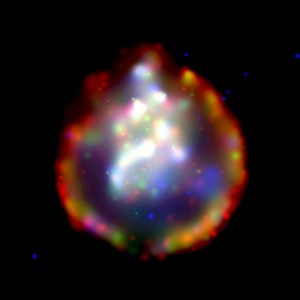
Photo (NASA Images): Star that exploded in a supernova leaving a ring that’s rich in oxygen.
A beautiful star-metaphor appeals to my sense that our cosmic journey has meaning:
The universe is made of stars, not atoms – Muriel Rukeyser
The /Xam San people of Southern Africa knew that humans were related to the stars in a mysterious way. The /Xan suffered a slow genocide in the 1800s but their words remain. Their stories tell us that the stars are closely connected to humans:
“The stars know the time at which we die.” –Díä!kwain, 1876
Tags: connections, science, Universe
Posted in Science, Universe | No Comments »
Wednesday, October 28th, 2020
Writing requires four fundamental steps:
Imagine: ‘Open your mind’ (P.D. James)
Write: ‘Put one word after another’ (Neil Gaiman)
Edit: ‘Omit needless words’ (William Strunk)
Hope: ‘Outrun the self-doubt’ (Stephen King)
The steps of writing harmonise with the four fundamental forces of the physical world:
Electromagnetism: has infinite range, like imagination,
Weak Force: is confined to the atoms, as a writer must be confined to work.
Strong Force: holds nuclei together, as editing strengthens writing.
Gravity: keeps us anchored and has infinite range, like hope.
Read my essay, The Science of Writing.
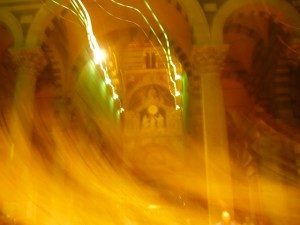
Tags: books, connections, science, writing
Posted in Science, Universe, Writing | No Comments »
Saturday, January 7th, 2017
Am I really made of stardust? Yes, many of my (and your) atoms were made in dying stars – when the stars exploded (‘supernova’) the atoms were flung into the universe and eventually became planets and plankton and people. The atoms themselves have not changed but were constantly recycled into different matter – those same atoms of stardust make up 93% of my body mass (some are hydrogen atoms which are actually Big Bang dust). That means I’m billions of years old… which is strange but oddly hopeful.
‘Our presence in the universe is deeply rooted in this cosmic history.’– Marco Bersanelli, physicist.
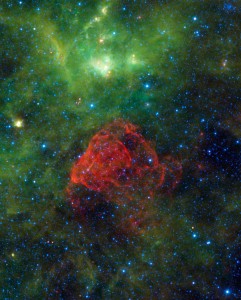 My Mum and Dad? The remnants of two ancient supernova explosions, Puppis and Vela. Image courtesy NASA/JPL-Caltech/UCLA
My Mum and Dad? The remnants of two ancient supernova explosions, Puppis and Vela. Image courtesy NASA/JPL-Caltech/UCLA
Tags: connections, science, Universe
Posted in Science, Universe | No Comments »
Saturday, June 27th, 2015
A Matter of Life and Death is both awesome and intimate, suggesting that a single tear shed for love might stop heaven in its tracks.- Roger Ebert
A Matter of Life and Death (1946) is a wonderful fantasy movie about an English pilot who’s in love with an American (it was made to boost post-war Anglo-American relationships). It begins with their unique ‘falling’ in love scene (that can be seen here) – the dead pilot argues his case in Heaven to be allowed to return to life. The scenes on Earth are in Technicolor while Heaven is in black and white (which makes it more surreal). The last words are from a Walter Scott poem:
‘For love is heaven and heaven is love.’
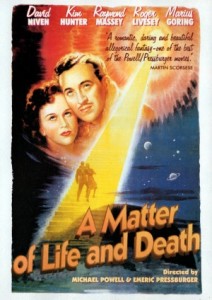
Tags: movies, Universe
Posted in Movies, Universe | No Comments »
Monday, June 15th, 2015
At last, a big picture is emerging in science as links have been found between the small and the large, between quantum physics and biology. The poster child of ‘quantum biology’ is the European robin. The bird uses the Earth’s magnetic field to navigate vast distances – but the field is 100 times weaker than a fridge magnet, so how does the robin detect it? It uses an very finely balanced system that reaches from the sub-atomic level to the biological. Here’s how it seems to work: a photon (‘particle’) of light enters the bird’s eye as it’s flying; the photon is absorbed by a protein molecule in the eye where it causes electrons to become ‘entangled’ (an electron state that’s sensitive to magnetic fields); this creates a chemical change in the protein molecule which sends a signal to the bird’s brain telling it which way to fly. This ‘magneto-reception’ occurs in many bird species (including chickens!), honey bees, dolphins, butterflies, sharks, lobsters and stingrays. This fascinating book tells the full story:
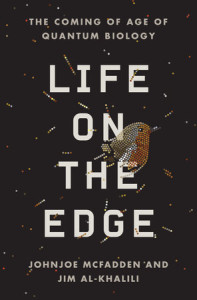
Tags: connections, science
Posted in Science, Universe | No Comments »
Sunday, August 10th, 2014
Does the universe have a purpose or is it an accident? Scientists have divergent views on the significance of the universe. At one end of the spectrum is the iconoclast, Richard Dawkins, who sees an indifferent universe which has “precisely the properties we should expect if there is at bottom no design, no purpose.” At the other end is biologist Jane Goodall who believes the universe is both purposeful and meaningful. In between there are theories ranging from a ‘conscious universe’ to a ‘self-creating universe’. Whatever their beliefs, at least there’s usually a shared sense of wonder among scientists…
…Read the rest of my essay, Science and Soul, here.
 Photo: The remnants of supernova explosions, Puppis and Vela, birthplace of some of our atoms. Image courtesy of NASA/JPL-Caltech/UCLA
Photo: The remnants of supernova explosions, Puppis and Vela, birthplace of some of our atoms. Image courtesy of NASA/JPL-Caltech/UCLA
Tags: connections, consciousness, science, Universe
Posted in Science, Universe | No Comments »
Monday, March 17th, 2014
The classic sci-fi movie, The Incredible Shrinking Man (1958), was about the atomic angst of the 1950s and it’s themes have not dated. The hero is exposed to a radioactive cloud and begins to shrink. Trapped in his home, he battles his cat, a spider, and a leaking tap (always a threat to the male ego). Finally, he’s reduced to his essential self and ponders his place in the universe. This extract is from the closing monologue (script by Richard Matheson):
So close – the infinitesimal and the infinite. But suddenly, I knew they were really the two ends of the same concept. The unbelievably small and the unbelievably vast eventually meet—like the closing of a gigantic circle…
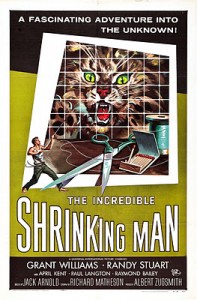
Tags: connections, movies, science fiction, Universe
Posted in Movies, Sci-Fi, Universe | No Comments »
Sunday, January 6th, 2013
Why Does The World Exist? by Jim Holt is a fascinating book that asks the question, ‘Why is there something rather than nothing?’ Holt looks at all sides of the question, interviewing scientists, philosophers, atheists and believers (Richard Swinburne, John Irving, Roger Penrose, Adolf Grunbaum…). There are three types of theorist:
The “optimists” hold that there has to be a reason for the world’s existence and that we may well discover it. The “pessimists” believe that there might be a reason for the world’s existence but that we’ll never know for sure… Finally, the “rejectionists” persist in believing that there can’t be a reason for the world’s existence, and hence that the very question is meaningless.
Leibniz’s Principle of Sufficient Reason says that ‘For every thing there must be a reason for that thing’s existence‘, which is the basis of our scientific worldview. Holt does a good job of summarizing some knotty philosophy, physics and maths (understanding it is another matter!). Although he offers no firm answers, the book left me feeling “optimistic”; and it’s oddly comforting that after picking the brains of the world’s greatest thinkers, Holt concludes,
No one can confidently claim intellectual superiority in the face of the mystery of existence.
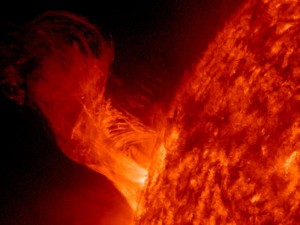
Photo: Solar eruption, Dec 31, 2012 – courtesy of NASA Images
Tags: books, connections, reviews, science, Universe
Posted in Book Reviews, Science, Universe | No Comments »
Tuesday, March 20th, 2012
Dark matter is the missing link.Stuart Clark
Our universe exploded into being about 14 billion years ago, for motives which are unclear. Equal amounts of matter and anti-matter were made but most of the anti-matter mysteriously disappeared. And so the universe became biased towards life (matter). But only a ‘mere- smear’ of the universe is Normal Matter – that’s the atoms in stars, planets, you and me – the bulk is dark stuff.
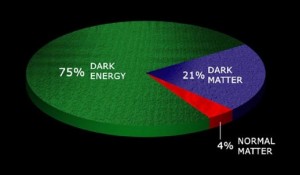
This pie (Image: NASA/CXC/M.Weiss) shows the ingredients of the universe. Most of it is Dark Energy that hides in the vacuum of space. We don’t yet know what it is, but it’s made the universe expand. Dark Matter is made of particles that are also invisible to us but we can see galaxies being affected by its force. The smallest slice of the universe is Normal Matter. Matter is built up from extremely small bits to extremely big bits: from inner space to outer space. Sub-atomic particles are arranged into atoms, atoms into molecules; molecules into cells and organisms; and so on up to galaxies and dark stuff. Everything belongs.
We exist only because of subtle connections between the very small and the very large. Charles Birch
Tags: connections, science
Posted in Science, Universe | No Comments »
Tuesday, February 28th, 2012
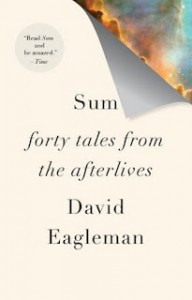 Sum, Forty Tales from the Afterlives, by David Eagleman, is a hugely entertaining, often thought-provoking book. Each very short story describes a quirky version of life after death. There is an afterlife populated only by people you remember; one where you are split into different ages; another where God is a married couple. Listen to Stephen Fry reading one about a highly ordered afterlife. The stories are not so much about theology or God (although He, She, and They do appear as somewhat fallible characters) as about treasuring the life we have now – plus a bit of humour and sci-fi just for fun. Here’s a video interview with Eagleman (a neuroscientist) who describes himself as a ‘Possibilian’– one who explores new ideas. (More novels about the afterlife).
Sum, Forty Tales from the Afterlives, by David Eagleman, is a hugely entertaining, often thought-provoking book. Each very short story describes a quirky version of life after death. There is an afterlife populated only by people you remember; one where you are split into different ages; another where God is a married couple. Listen to Stephen Fry reading one about a highly ordered afterlife. The stories are not so much about theology or God (although He, She, and They do appear as somewhat fallible characters) as about treasuring the life we have now – plus a bit of humour and sci-fi just for fun. Here’s a video interview with Eagleman (a neuroscientist) who describes himself as a ‘Possibilian’– one who explores new ideas. (More novels about the afterlife).
Tags: books, science fiction, Universe
Posted in Book Reviews, Sci-Fi, Universe | No Comments »
Tuesday, August 30th, 2011
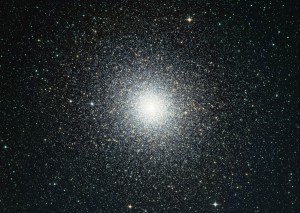 Nga ra o mua is a Maori phrase for the past; translated as ‘what is in front’. The past is spread out in front of us – it’s what is known. It’s literally true when we look at the stars: the light we see left the stars perhaps millions of years ago. The past is spread out in the sky. Nga ra o mua also fits the physics concept of a universe in which all points of time exist together. For example, about now on August 30, 1871, Ernest Rutherford is being born. It also explains why it’s hard to leave the past behind. Pam Morrison wrote eloquently about this in her blog. Photo: a million stars (NASA Images)
Nga ra o mua is a Maori phrase for the past; translated as ‘what is in front’. The past is spread out in front of us – it’s what is known. It’s literally true when we look at the stars: the light we see left the stars perhaps millions of years ago. The past is spread out in the sky. Nga ra o mua also fits the physics concept of a universe in which all points of time exist together. For example, about now on August 30, 1871, Ernest Rutherford is being born. It also explains why it’s hard to leave the past behind. Pam Morrison wrote eloquently about this in her blog. Photo: a million stars (NASA Images)
Tags: science, Universe
Posted in Science, Universe | No Comments »
Sunday, March 27th, 2011
As we dig deeper and deeper using scientific methods, we continue to find rational and meaningful order Paul Davies
 Still pondering the ‘mindful’ universe. It is ‘finely tuned’ to support life — indeed, it seems to be geared towards the creation of ‘mind’. Then there’s the question of meaning. Twelve leading scientists and thinkers were asked, Does the universe have a purpose? Five of them answered ‘Yes’, two said ‘No’, and the others were everywhere in-between (including one ‘I hope so’). Read their fascinating responses here. Jane Goodall’s personal response recalls a transcendent moment in a cathedral.
Still pondering the ‘mindful’ universe. It is ‘finely tuned’ to support life — indeed, it seems to be geared towards the creation of ‘mind’. Then there’s the question of meaning. Twelve leading scientists and thinkers were asked, Does the universe have a purpose? Five of them answered ‘Yes’, two said ‘No’, and the others were everywhere in-between (including one ‘I hope so’). Read their fascinating responses here. Jane Goodall’s personal response recalls a transcendent moment in a cathedral.
How could I believe that blind chance had led to that moment in time — the cathedral, the collective faith of those who had prayed and worshiped within, the genius of Bach, the emergence of a conscious mind that could, as mine did then, question the purpose of life on Earth Jane Goodall
I once heard the beautiful Monteverdi Choir in Pisa Cathedral (photo) – quite by chance, but hopefully not blind chance! It was a ‘moment in time’ for me, the voices lingering in the air long after the singing stopped…
Tags: mind, Paul Davies, science, Universe
Posted in Science, Universe | No Comments »
Thursday, February 3rd, 2011
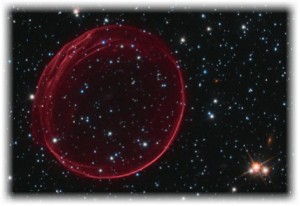
Photo: Mysterious cosmic egg (supernova): NASA Images
I love a good mystery: in my 20s it was the search for God; then family mysteriously absorbed 30 years; and now questions rise again: What is the purpose of life? What is quantum physics? Consciousness? And why am I always the one on the spot when the loo paper runs out?
I’ve cobbled together the following Great Mysteries (with much help from pop-science books):
Around 14 billion years ago (for motives which are unclear) matter gained an advantage over anti-matter and the universe became slightly biased towards life. But only a ‘mere- smear’ of the universe is ordinary matter – galaxies, elephants, us – the bulk is ‘dark stuff’ which is mysteriously connected to the rest. Matter is made of atoms, which are energetic, enigmatic little tykes. An electron inside an atom behaves like a two-year old – it seems to be everywhere at all times – but when humans give it some attention, its behaviour changes. Intriguing. The little grey cells (our brains) enfold another mystery: consciousness. So we’re able to find meaning in life: we can make up our own minds.
And now the story takes a twist, from science towards soul. Mystical biologist Charles Birch reckoned that the whole universe is made of ‘mind stuff’. He suggested that even electrons have a whiff of consciousness:
We exist only because of subtle connections between the very small and the very large.
It seems to be all about connection and meaning, and I admit I’m biased towards finding both – hopefully without scrambling the cosmic egg. But I’ll leave you with a more appealing metaphor, by poet Muriel Rukeyser (I’m off to buy loo paper).
The universe is made of stories, not atoms.
Tags: Charles Birch, consciousness, dark matter, electrons, mind, science, Universe
Posted in Science, Universe | 1 Comment »












